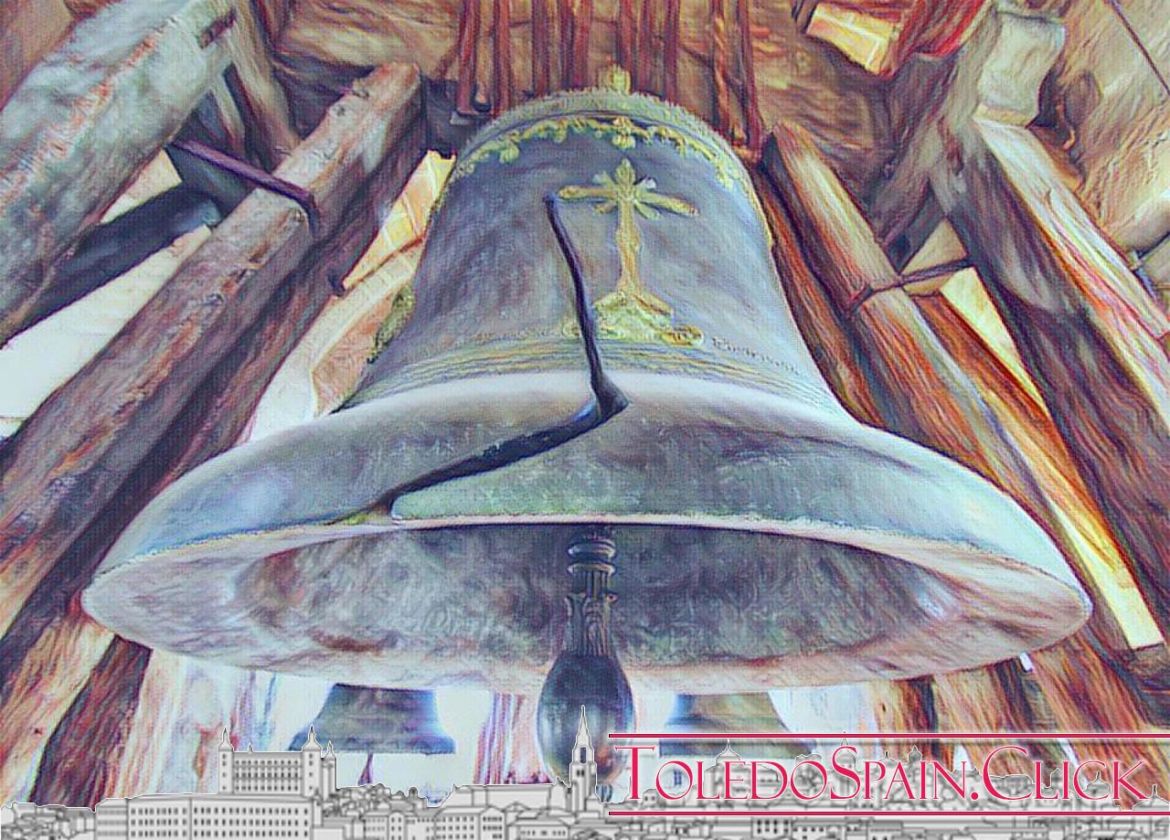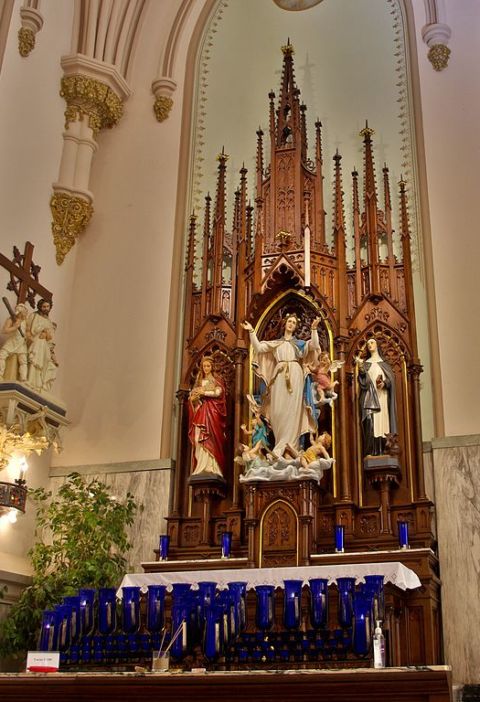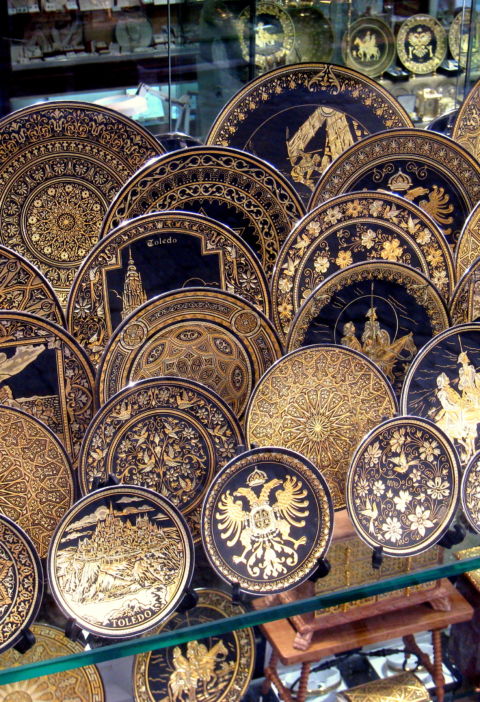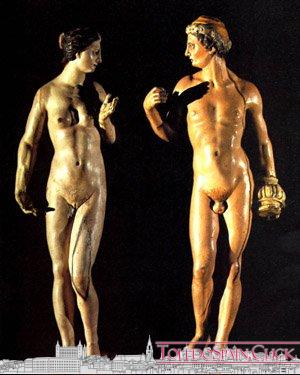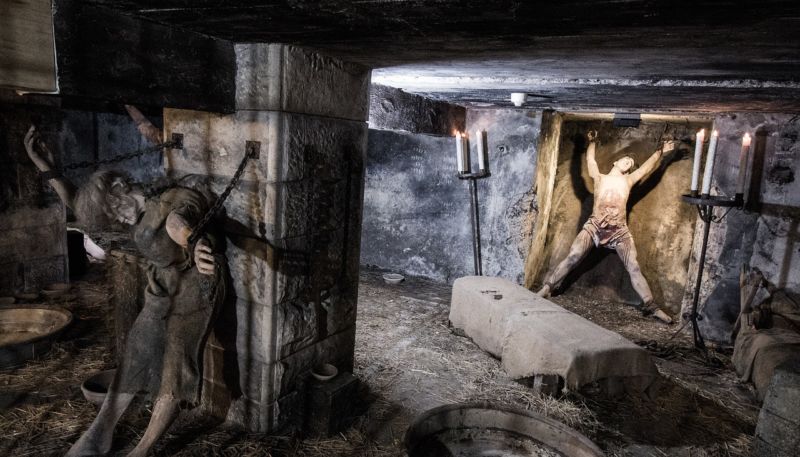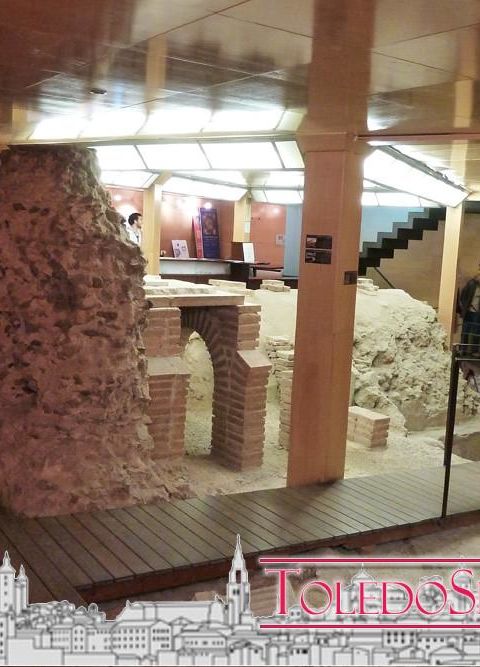If there is a building in Toledo that keeps between its foundations the glories of a past of centuries, a mixture of Visigoths, Arabs and Christians, that is the convent of Santa Fe. Roman pretors, Visigoth kings, Muslim governors and various religious orders (Franciscans, Calatravos, santiaguistas…) have passed through it An article by José García Cano.
And certainly what we can appreciate today differs greatly from those Palaces of Galiana as they were called in the eleventh century when Alfonso VI arrived in the city and that according to chronicles was also the palace of King Wamba [1]. According to Florián de Ocampo, an old proverb in the kingdom of Toledo was used to imply that one thing was very great: It was said “that they are some Palaces of Galiana…”. [2]
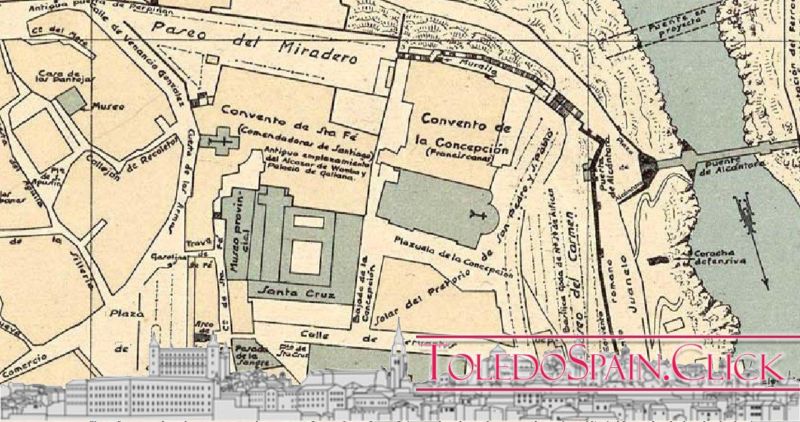 Section of the Toledo map by Rey Pastor, 1926. Source: www.ign.es
Section of the Toledo map by Rey Pastor, 1926. Source: www.ign.es
We have documented that in 1210 King Alfonso VIII ceded to Don Ruy Díaz Maestre of the Order of Calatrava one of the four fortresses of Toledo [3], specifically the one that they claim to have been Palaces of Galiana, within the walls of Toledo and which included the chapels of Santa Fe [4] (probably founded by Alfonso VI under the influence of Doña Constanza de Borgoña) and Belén, the latter being considered a true jewel of the ensemble as it is considered to be of Taifa origin and whose horseshoe rib vault demonstrates the link with Cordovan architecture from the time of Al-Haquen II [5]. At that time, the Master of the Order of Calatrava founded a priory there and had a church built with the title and name of Santa Fe [6] during the second half of the 13th century, from which its Gothic-Mudejar apse remains. Four clergymen were ordered to live there, with whom the Calatravian knights were to confess. In addition, in this church of Santa Fe, the knights of the order who died in Toledo or near here were to be buried, as was done until the 15th century. The texts of the gravestones of some of those Calatravos, such as the following one, are preserved:
HERE YAZE FREY RAMIR LORENZO, FIIO DE FERNAN LORENZO GALLINATO, E CLAVERO QUE FUE DE CALATRAVA, E CRIADO DE DON IVAN, FIIO DEL INFANTE DON MANUEL [7]
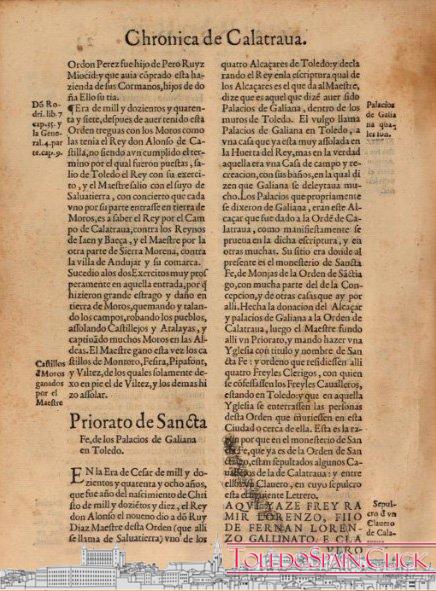 Chronicle of the three Orders and cavalries of Santiago, Calatrava and Alcantara… Frey Francisco de Rades and Andrada. Toledo, 1572. Chronica de Calatrava, p. 23-v.
Chronicle of the three Orders and cavalries of Santiago, Calatrava and Alcantara… Frey Francisco de Rades and Andrada. Toledo, 1572. Chronica de Calatrava, p. 23-v.
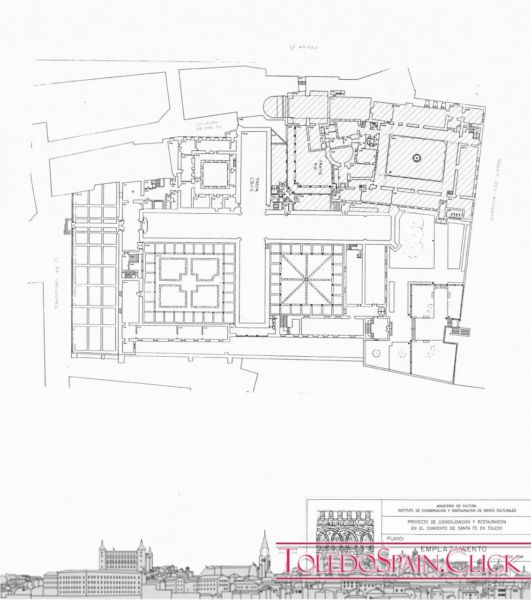
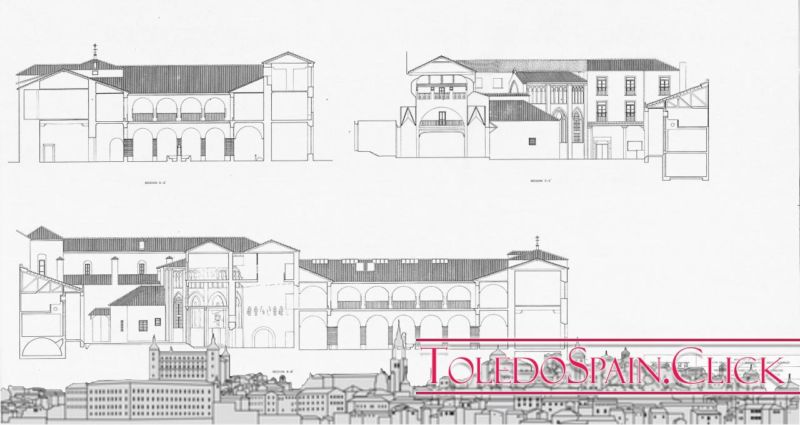
Plans of the Convent of Santa Fe de Toledo. Ministry of Culture. Institute for the Conservation and Restoration of Culturel Heritage. Consolidation and restoration project. March 1996
Until the time of the Catholic Monarchs, the Calatravos occupied this convent and Priory of Santa Fe, specifically until 1484, when the aforementioned kings ceded part of the Palaces of Galiana and the church of Santa Fe to the nuns of Concepción Francisca, headed by Doña Beatriz de Silva. The latter would be a short space of time, since in 1505 [8] the Comendadoras de Santiago [9] would arrive, transferring the Conceptionists to what had been the convent of San Francisco [10], where they are still today. It would be in these circumstances, when King Ferdinand ceded to the Order of Calatrava, as compensation for having displaced them from Santa Fe, the “greater synagogue that the Jews had in Toledo” [11], that is, the Transit Synagogue, which once Christianly consecrated would be dedicated to St. Benedict, creating the so-called Priory of St. Benedict, to which they also took the archives of the order [12].
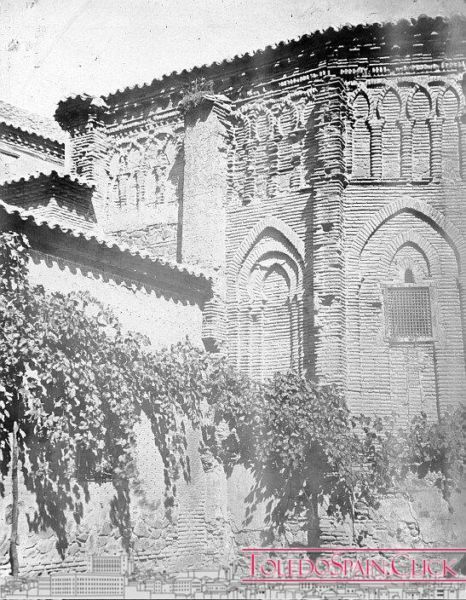 Convent of Santa Fe, exterior apse of the chapel of Santa Fe. Fountain: Toledo Municipal Archive. Casiano Alguacil collection.
Convent of Santa Fe, exterior apse of the chapel of Santa Fe. Fountain: Toledo Municipal Archive. Casiano Alguacil collection.
Santa Beatriz de Silva
We will stop at that stage in which part of the Palaces of Galiana were occupied by the conceptionists headed by Beatriz de Silva, protagonist of certain miracles that we will now detail. Beatriz was the daughter of Ruy Gómez de Silva and Isabel de Meneses, of Portuguese origin and who would become the founder of the Order of the Immaculate Conception. Beatrice, the beautiful Beatrice, arrived in Castile in 1447 accompanying Isabel of Portugal, who was coming from the neighbouring country to marry the king of Castile, John II, as a maiden. From her work as a maid and a woman close to Isabel, Beatriz was not lacking in people who envied her and tried to sully her name. As was normal in any court, intrigues and deceptions followed and involved nobles, religious and good people. One of the hoaxes that ran through the corridors of the palace was that the king had Beatriz as his lover, so the queen, who at first had her as a friend and close people, began to distrust and hate her, to such an extent that she kept her locked -according to the chronicles- for 3 days in an ark, “where she, not discovering this error of her lady, did not dare to give voices or ask for help” [13]. In such an extreme and distressing situation, Our Lady appeared to Beatrice to indicate that she would be freed. Following that vision, the young Portuguese woman decided to offer her virginity to Mary and to consecrate her life to the Mother of God.
Beatriz de Silva would arrive in Toledo around 1451, after the successor of the ark, entering the convent of Santo Domingo el Real as a stepping stone, where she would remain for more than thirty years and where she would mature very patiently and devoutly, the project of founding an order, which would be the Order of the Conception.
After a few years, the daughter of Isabel of Portugal and John II would have a special affection for Beatriz, and every time she came to Toledo, she would visit and talk with her; we are referring to Queen Isabel the Catholic. Thanks to her and to the cession she made to Beatriz of the aforementioned part of the Palaces of Galiana, the creation of the Order of the Immaculate Conception would begin to materialize.
At the express wish of Beatrice herself, the Order had to have its own rule, prayer and habit. For this reason, Pope Innocent VIII was asked for the opportune regulation, although this was granted but according to the Cistercian rule. The history of the Bull [14] signed by Innocent VIII to authorize the creation of the Order is incredible to say the least. The approval of the creation of the Order was signed by Pope Innocent VIII on April 30, 1489. Exactly that same day, a very mysterious person appeared around the provisional convent of Santa Fe, asking precisely for Doña Beatriz de Silva and communicating to her the signature of the bull by the Pope. Thus, in this instantaneous way, our saint knew in Toledo what had happened in Rome, according to tradition, by divine revelation. Saint Beatriz believed that the divine messenger was Saint Raphael, to whom she was very devoted, because she prayed to him every day.
The story of the bull doesn’t end there. It is said that the ship carrying the papal document to Spain was shipwrecked, and Beatriz, grieved and heartbroken by the terrible loss, cried for up to three days [15]. Shortly afterwards, Beatriz went to open a coffer and, amazed and surprised, found within it the bull lost in the shipwreck…
We will have to wait until August 1491 to learn about the transfer of the “miracle bull” from Toledo Cathedral to Santa Fe Convent. The procession was accompanied by a large number of Toledans showing the veneration and joy they felt towards Beatriz and the new order that was being formed. During that transfer, Father Francisco García de Quijada announced that fifteen days later, the habits and veils of Beatriz and her companions would be taken in the chapel of Santa Fe.
I’m sure you’re also interested in: Curiosities of the Plaza de Zocodover in Toledo
But divine destiny had another surprise in store for Beatrice. Five days after the transfer of the bull to Santa Fe, the Virgin appeared to her while she was praying (August 7, 1491), to inform her that “from today to ten days you must go with me…”. On August 17, precisely the day chosen for the taking of habits, our beloved Beatriz de Silva died [16]. Under Cardinal Mendoza’s permission, she would receive the habit of the Conception and the veil, and made her profession in accordance with the provisions of the Bull [17]. When they gave her the holy anointing, something incredible happened because when they removed the veil from her face to give her the anointing, the brightness was such that from her face came out that everyone was frightened; besides, they could see how in the middle of her forehead a star appeared to her, which was visible until she expired, giving as great light and brightness as the moon when it shines the brightest. All this was witnessed by six Franciscan friars [18].
His death did not end the incredible events around Beatriz de Silva. Beatriz had promised her confessor that she would show him her face, always veiled, before dying, for which she appeared to Father Tolosa when he was in the convent of Guadalajara, begging him to go to Toledo as soon as possible because his house and order were very much in need of his help, as it was, because of the disagreements that arose between the convent of Santo Domingo el Real and the Franciscans over the custody of the remains of the saint [19].
The Order of the Immaculate Conception had been born almost at the same time as its founder left this earthly world and her work and foundation would remain for centuries as an example of faith and devotion, remaining the community of nuns in our city of Toledo and in that environment so full of history as were the Palaces of Galiana. Saint Beatriz de Silva was beatified in 1926 and canonized by Paul VI in 1976, a little more than forty years ago.
The Infanta doña Sancha Alfonso
Without leaving aside the topic of miracles in Santa Fe, we should not overlook a space that we have already mentioned, such as the chapel of Belén, very interesting at an archaeological level and where an illegitimate daughter of Alfonso IX de León, Sancha Alfonso, is buried. Doña Sancha, born in 1220, was a professed nun of the Order of Santiago being buried in the convent of Santa Eufemia de Cozuelos, although in 1608 and with the authorization of King Felipe III she would be transferred to Toledo [20], to the convent of Santa Fe and specifically to the chapel of Belén -to the right of the altar-. His incorrupt body was deposited in 1615 [21] and a halo of sanctity ran around Sancha because after his death various miracles were documented in the city of Toledo [22]. She was only given the title of venerable because her process of beatification began without prospering. Among the documentation attached to the opening of the process, we have the case of Sebastián Llanos, who suffered an accident by the hitting of a horse producing “a large and deadly wound that completely broke his helmet and were uncovered cervices” of which he cured when he was put some powders from the sepulchre of the servant of God Doña Sancha. Or that of Maria Aguada, resident of Toledo, who was “taken off the trial” and was crazy six months, “in which he did various and extraordinary actions of crazy” and gave great voices and cries and having taken inside the convent of Santa Fe, to the chapel of Our Lady of Bethlehem, “where the body of the blessed servant of God is venerated, she was entrusted there and a little piece of the tunic with which the said Lady Sancha was buried, then she calmed down and made no movement, and in a few days she was in full health…”. Curious is also the miracle that happened to Juana Rodriguez, maiden and daughter of Francisca Rodriguez, who being sick of continuous heat, was taken to the Hospital of Outside [23] from where she fled half naked and walked through the public streets which continued doing so for two months in such a way that the boys made fun of her and having one day entered the church of the convent of Santa Fe, and having drunk water with powders from the grave…

